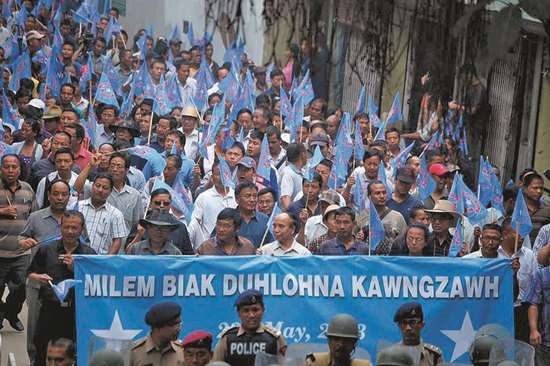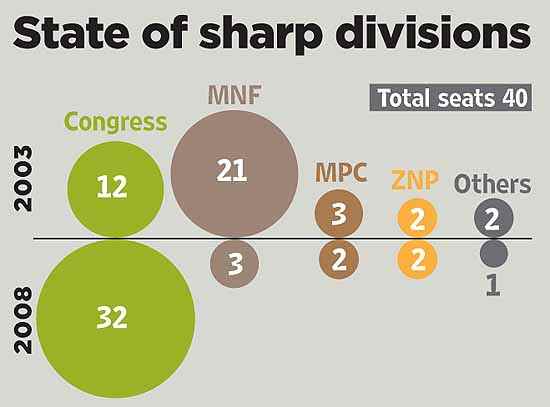
Crying blue A Mizo National Front rally in Aizawl protests Lalthanhawla’s ‘idol worship’
elections: mizoram
The ruling Congress fights charges both religious and temporal in Mizoram
Election
season in Mizoram has had one riveting controversy that has whipped up
mass interest. It concerns the Hindu ‘tilak’ that has been the
generating news in the last stage of the campaign in this predominantly
Christian state. Posters featuring the ruling Congress CM Po
Lalthanhawla with a tilak, supposedly from his visit to a puja pandal in
Calcutta in 2011, have been widely circulated by opposition parties to
extract maximum mileage. Rallies have also been organised to argue how
the CM violated key Christian tenets.
The CM, on his part, hasn’t taken it lying down, even arguing that pastors from Mizoram have had the tilak applied on them on outstation visits. This only infuriated the Church, that rushed to defend the piety of its pastors. In a state where the Presbyterian and Baptist churches are powerful, many believe this controversy can harm the Congress’s poll prospects in conservative rural areas. So powerful is the Church that it has ‘banned’ football on Sundays and runs a self-appointed and strict election monitor—Mizoram People’s Forum (MPF). The Election Commission even chose to change the original date of the poll from December 4 to November 25 as it clashed with the Presbyterian church’s conference.
It is in the backdrop of this surreal debate, under the stern and almost minatory glare of an ubiquitously powerful Church, that Mizos are queuing up to elect their new legislators on Monday. The opposition Mizoram Democratic Alliance (MDA)—a grouping of the Mizo National Front (MNF), Mizoram People’s Conference (MPC) and the Maraland Democratic Front (MDF)—is taking a shot at unseating the Congress government that holds 32 of the 40 assembly seats. Lalthanhawla claims his party will better 2008’s score, but most analysts give the Congress a lower tally. The MDA, on the other hand, hopes to pocket around 25 seats this time.

Photograph by AFP, From Outlook 02 December 2013
The
ruling Congress expects a rich harvest from its New Land Use Policy
(NLUP), a programme it started after 2008, whereby farmers are given Rs 1
lakh each to better their income generation. But opposition parties
have been quick to point out how many NLUP beneficiaries are either
Congress loyalists, or how the party has wastefully doled out money to
barbers, tailors and desktop publishers. “Only a handful of the
beneficiaries have received the entire amount,” says MNF Rajya Sabha MP
Lalhming Lianga. “The Congress has failed in implementing any sort of
long-term development and financial management goals.” MPC secretary
Michael Lalthanmawia makes the same point. “Our biggest criticism of
the Congress is how it focuses only on short-term benefits, not on
policies that look even beyond two years.”
The opposition alliance was cobbled together after protracted
negotiations and has the MNF contesting from 32 seats and the MPC from
the remaining eight. In 2008, the two parties, despite having won 41 per
cent of the votes, had won just four seats. The Congress, with a
voteshare of less than 39 per cent, had won 32. The MNF and the MPC hope
they have found a way to convert votes into seats with this
seat-sharing agreement. The two had last forged an alliance in 1998, and
had managed to throw out the Congress that had been in power for two
consecutive terms since 1989. “Our faithful added together are more or
less sufficient to get us to victory. It has nothing to do with the
Congress’s weaknesses or strengths,” says Lalthanmawia.
 The ruling Congress expects to hold on to power in Mizoram,
fighting off an alliance between two major opposition parties, MNF and
MPC, and a minor party, MDF
The ruling Congress expects to hold on to power in Mizoram,
fighting off an alliance between two major opposition parties, MNF and
MPC, and a minor party, MDF
While the Congress expects benefits from its assistance programme for farmers, the opposition accuses it of little long-term development planning
71-year-old CM Lalthanhawla has held office on four earlier occasions
Despite there being more women voters, Mizoram has only seven women
contesting among 141-odd candidates
Unlike the rest of the country, where poll campaigning often at least partly reflects the ‘macro’ issues, the campaign in Mizoram for each candidate has been structured around local issues. “Almost all candidates have fought around local issues, such as poor condition of roads, inadequate electricity supply and scarcity of cooking gas,” adds Lallianchhunga, assistant professor of political science at Mizoram University in Aizawl.
To return to the tilak controversy, K. Sapdanga, editor of Mizo newspaper Vanglaini, feels it can anger people in rural areas, where they tend to be “less secular”. MNF MP Lianga adds, “It’s not the fact that he went to a pandal but that he performed their religious rites that has hurt the sentiments of Christians.... It is a minus point.” Not to be outdone, the Congress released a poster of the MNF’s founder-president, the late Laldenga, attending a ceremony in a gurudwara. It showed him garlanded, with his head covered with a white cloth, a traditional accoutrement while entering a gurudwara.
Some analysts have interpreted the row over the tilak—and the ‘bowing to foreign gods’—as an attempt to accentuate Mizo nationalism to counter the influence of the ‘mainland’ Congress. If its proponents once used the bullet, they are hoping the ballot can express the sentiment now. That’s easier said than done. “Mizo nationalism is still widespread amongst the youth, something it expresses widely through social media. But it is complicated for the opposition to translate this into votes,” says Lallianchhunga.
While a loss for the Congress in Mizoram may not fit in with the larger binary political narrative of BJP versus the Congress ahead of 2014, a defeat for the grand old party in a state with just one Lok Sabha seat can still deliver a sharp kick to its shin.
source: Outlook India
The CM, on his part, hasn’t taken it lying down, even arguing that pastors from Mizoram have had the tilak applied on them on outstation visits. This only infuriated the Church, that rushed to defend the piety of its pastors. In a state where the Presbyterian and Baptist churches are powerful, many believe this controversy can harm the Congress’s poll prospects in conservative rural areas. So powerful is the Church that it has ‘banned’ football on Sundays and runs a self-appointed and strict election monitor—Mizoram People’s Forum (MPF). The Election Commission even chose to change the original date of the poll from December 4 to November 25 as it clashed with the Presbyterian church’s conference.
It is in the backdrop of this surreal debate, under the stern and almost minatory glare of an ubiquitously powerful Church, that Mizos are queuing up to elect their new legislators on Monday. The opposition Mizoram Democratic Alliance (MDA)—a grouping of the Mizo National Front (MNF), Mizoram People’s Conference (MPC) and the Maraland Democratic Front (MDF)—is taking a shot at unseating the Congress government that holds 32 of the 40 assembly seats. Lalthanhawla claims his party will better 2008’s score, but most analysts give the Congress a lower tally. The MDA, on the other hand, hopes to pocket around 25 seats this time.

Photograph by AFP, From Outlook 02 December 2013
|
***

While the Congress expects benefits from its assistance programme for farmers, the opposition accuses it of little long-term development planning
71-year-old CM Lalthanhawla has held office on four earlier occasions
Despite there being more women voters, Mizoram has only seven women
contesting among 141-odd candidates
***
With the country’s attention focused on polls in Delhi, Rajasthan,
Madhya Pradesh and Chhattisgarh, Mizoram has had a quiet season. The
main reason is the Church-supported MPF, a self-appointed monitor that
acts as the de facto election commission in the state, with its
stringent but widely adhered to code of conduct for campaigning. This,
as a local journalist explains, gives state capital Aizawl a deserted
look even at the peak of the campaign season. The MPF even organises
debates with candidates from different parties. “People here tend to see
the Church as a force that can guide the society, see it as one that
can put out a code of conduct,” says R. Lalrinkima, assistant professor
at Kamala Nagar College in Chawngte.Unlike the rest of the country, where poll campaigning often at least partly reflects the ‘macro’ issues, the campaign in Mizoram for each candidate has been structured around local issues. “Almost all candidates have fought around local issues, such as poor condition of roads, inadequate electricity supply and scarcity of cooking gas,” adds Lallianchhunga, assistant professor of political science at Mizoram University in Aizawl.
To return to the tilak controversy, K. Sapdanga, editor of Mizo newspaper Vanglaini, feels it can anger people in rural areas, where they tend to be “less secular”. MNF MP Lianga adds, “It’s not the fact that he went to a pandal but that he performed their religious rites that has hurt the sentiments of Christians.... It is a minus point.” Not to be outdone, the Congress released a poster of the MNF’s founder-president, the late Laldenga, attending a ceremony in a gurudwara. It showed him garlanded, with his head covered with a white cloth, a traditional accoutrement while entering a gurudwara.
Some analysts have interpreted the row over the tilak—and the ‘bowing to foreign gods’—as an attempt to accentuate Mizo nationalism to counter the influence of the ‘mainland’ Congress. If its proponents once used the bullet, they are hoping the ballot can express the sentiment now. That’s easier said than done. “Mizo nationalism is still widespread amongst the youth, something it expresses widely through social media. But it is complicated for the opposition to translate this into votes,” says Lallianchhunga.
While a loss for the Congress in Mizoram may not fit in with the larger binary political narrative of BJP versus the Congress ahead of 2014, a defeat for the grand old party in a state with just one Lok Sabha seat can still deliver a sharp kick to its shin.
source: Outlook India







0 comments:
Post a Comment